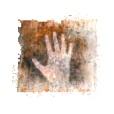Frances Dyson, And then it was now
9 Evenings
Grass Field, Alex Hay’s dance piece for 9 Evenings, can be seen as an investigation of both wireless connectivity and the externalization of the body’s internal functioning: heartbeats, the breath, muscle contractions and even brain waves were to be amplified and projected on a large screen behind the performance space. In an interview with Alfons Schilling, Hay mentioned that he initially wanted to use the moveability and flexibility of sound so that the audience could hear sounds transmitted from a variety of sources not necessarily proximate to the loundspeakers. Moreover, he wanted the actual sounds rather than their electronic representation. (1)
The performance itself was beset with problems: the transmitters did not work through to the end of the series, although the amplifiers did, “so what I got was eye muscle movement pickup, and some heartbeat [...] and then I was picking up muscle potentials in my back, and that worked throughout the first night, but it had an FM radio station superimposed over it.” (2) Even when the brain wave signals, which were extremely difficult to isolate, started coming through as low thundering sounds during the latter part of the second performance, “David [Tudor] thought that was some kind of a mistake and cut it off [laughs].” (3)
Alex Hay: Mapping the Body
Projected on a screen, the large image of Alex Hay’s face (with electrodes placed at his temples) looking at times meditative and at times concerned, and the strange ritual of his “dance” as he crossed the stage carrying a peculiar “body pack,” replete with small transistors, on his back — all this looked like something out of a science fiction film. No wonder then that Alfons Schilling, in his interview with Hay, asked him if he “cared to have an artificial arm” and then moved on to the topic of implants, life in outer space and so on. Although Hay said that he “wanted to get the manipulation of my body by mechanical means,” he stressed that he was “not interested in mechanized man.” (4) Nor did he, in referring to his piece, use any of the cyborgian rhetoric employed by later artists, especially Stelarc.
It appears that Hay’s real interest was in the body and its “potentials.” “I wasn’t,” he said, “going to program anything to enhance certain sounds — I mean what sounds came, came as a function of the activity I was doing and as a result of the organs.” (5) Thus the sounds produced or amplified were aural indicators of the state of Hay’s body at the time, rather than aesthetic elements used in, say, a sound composition. They were documentary rather than representative, and their function was to reveal the “truth” of the body without the mediation of its surface, the skin.
Although radically different in intent, the kinds of research and engineering processes that Hay’s project entailed were very similar to the medical research and requirements that the Australian performance artist Stelarc has used — especially, for instance, in his “stomach sculpture.” (6)
As the engineer Robby Robinson wrote after 9 Evenings:
“The process of becoming familiar with what type of sounds existed in the body and with what type of sensors to pick them up became a learning process in itself. Specialists at several hospitals were consulted [and] medical supply houses were quizzed [for appropriate sensors]. [...] The problems were formidable. The type of amplifiers needed for this type of sound were not available commercially [so] about ten days before the performance, a new approach using integrated circuits was decided upon. [...] The engineers sweated blood over these little boxes that would not stabilize and produce those elusive sounds of the body.” (7)
Frances Dyson © 2006 FDL
(1) Alex Hay Interview with [Alfons] Schilling / Alfons Schilling (1966, 1 sound tape reel (44 min.): analog; 7 in. Original). Experiments in Art and Technology. Records 1966-1993, Research Library, The Getty Research Institute, Los Angeles, California (940003). Transcriptions by the author.
(2) Ibid.
(3) Ibid.
(4) Ibid.
(5) Ibid.
(6) According to Stelarc, “the idea was to insert an art work into the body — to situate the sculpture in an internal space. The body becomes hollow, with no meaningful distinctions between public, private and physiological spaces. The technology invades and functions within the body not as a prosthetic replacement, but as an aesthetic adornment. One no longer looks at art, nor performs as art, but contains art. The hollow body becomes a host, not for a self or a soul, but simply for a sculpture.” (reference of: August 8, 2006): http://www.stelarc.va.com.au/stomach/stomach.html
(7) What Really Happened at The Armory / Robby Robinson (March 16, 1967), 44 sheets. Experiments in Art and Technology Records, 1966-1993, Research Library, The Getty Research Institute, Los Angeles, California (940003).
Index:
- Enduring Rhetorics
• Artists's Tangle
• Sound's Pre-Mix
• Three Phases of Rhetoric
• Billy Klüver - 9 Evenings
• Emerging Aesthetics
• John Cage
• Alex Hay
• David Tudor - The Pavilion
• Why the Pavilion?
• Sound
• Environment and Cybernetics - Art and Technology
• Artist meets Engineer
• E.A.T. meets Pepsi
• Automation meets Arts


